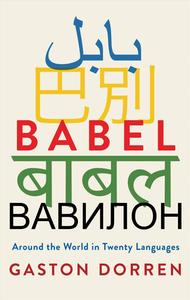
 If you spoke all of the 20 languages featured in Babel, you could talk with half the world, claims popular linguistics writer Gaston Dorren (Lingo: Around Europe in Sixty Languages). That said--the greatest polyglot in this book is a Cameroonian named Jonas who speaks eight. Dorren offers an intriguing tasting-menu of the major standardized languages, one chapter for each.
If you spoke all of the 20 languages featured in Babel, you could talk with half the world, claims popular linguistics writer Gaston Dorren (Lingo: Around Europe in Sixty Languages). That said--the greatest polyglot in this book is a Cameroonian named Jonas who speaks eight. Dorren offers an intriguing tasting-menu of the major standardized languages, one chapter for each.
Trade and imperialism were the major forces that spread most of these languages among so many people. Some, such as German, Korean and Tamil, "happen to occupy compact but densely populated regions." Still others owe a widespread popularity to their historic status as official colonial administrative languages. "Most have this in common: they are lingua francas--languages that bridge the gap between people with different mother tongues."
At the beginning of every chapter, Dorren offers some basic facts about its subject, such as number of speakers, geographic range, loanwords and accent obstacles. These are followed by an idiosyncratic essay on whatever has struck him about that language: the ideophones of Korean, Bengali script, the "language revolution" of 20th-century Turkish and the "linguistic gender apartheid" of Japanese. The chapter on Arabic centers on a "concise dictionary" of words that have some relationship with English. The text is enlivened with illustrations and charts and supplemented by sound files on a website. There is a good index. For the most part, this book is not at all technical except for Dorren's occasional use of phonetic symbols. A final section offers resources for learning the languages, only one or two in most cases, though many more for the one he struggled to learn for this project--Vietnamese.
Dorren's themes include the sense of correctness people have around different aspects of their languages, the cultural knowledge required for true fluency, the joys and challenges of multilingualism and, conversely, the sense of belonging that shared language can provide. "Marking identity is what language does best: as a means of communication our speaking and writing can go badly awry at times, but we're all experts in spotting accents, words and other linguistic traits that set people off from our own group." This is an engaging and informative whirlwind tour of how major world languages are created, used and changed. --Sara Catterall
Shelf Talker: This is an entertaining look at 20 of the world's major languages, their histories, cultural contexts, difficulties and quirks.

